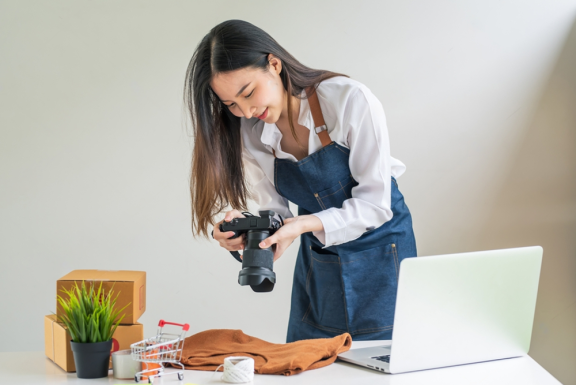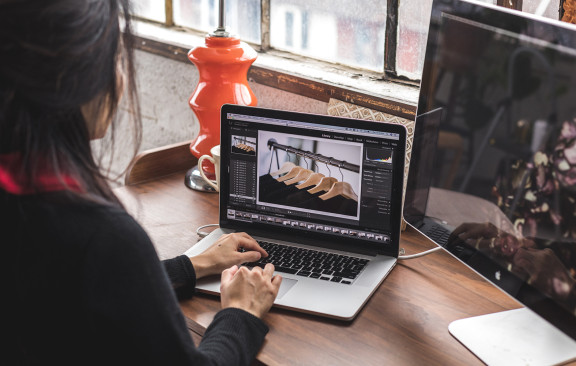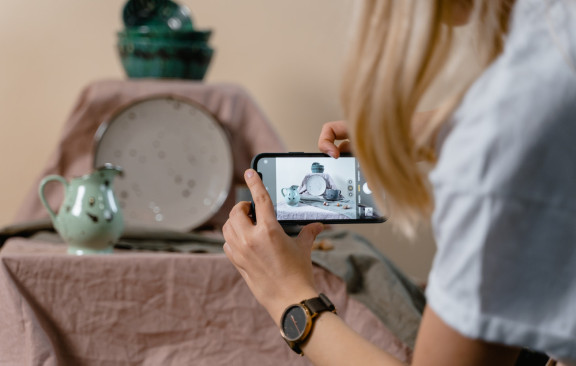How do I get pictures of dropshipping products?
💡 Quick Answer: The easiest way to get pictures for your dropshipping products is to ask suppliers to provide images you can use. These are often high-quality and show the product from different angles. Alternatively, you can order a product sample and take your own photos. This will allow you to add unique backgrounds, use specific angles, and make your store stand out. If you use any third-party images, always check with the owner to ensure you're allowed to use them for your store.
We all know that product images can make or break eCommerce sales. Online shoppers can't touch or try out your products, so they rely almost entirely on images when making buying decisions.
So, how do you make sure your product images are top-notch and drive sales?
It can be slightly more challenging for a dropshipping store than the average eCommerce site. But it's still easily doable with the right strategies and tools.
And it's what we're going to cover in this guide. You'll learn practical tips and tactics to help you get those perfect shots. From sourcing images directly from platforms to snapping your own professional-looking photos, we'll reveal everything you need to know about dropshipping product images.
Ready to give your dropshipping business a competitive edge? Let's dive in.
Ways to get photos of products you are dropshipping
There are a few ways to get eye-catching product images that make your customers hit the 'Add to Cart' button. Some require more time and resources than others. So, let's kick things off with the most low-effort tactic.
Directly from dropshipping platforms
If you're sourcing your dropshipping products through SaleHoo or AliExpress, you can download free images directly from the platform. Simply open the image in a new window, right-click, and select 'Save image as.'

The big thing to look out for here is image quality. You need clear, high-resolution photos showing your product in the best light.
Once you've downloaded your images, organize them in folders. This will save you a ton of time when you're updating your store.
If you're using SaleHoo Dropship, you can speed up the process of adding product images to your Shopify dropshipping store. Add products to your import list, and you can create listings on your store in bulk, including importing all the product images.

It's essential that your product images match your store's existing branding. If your store has a minimalist vibe, choose pictures that fit that style. If your store is more vibrant and colorful, look for images that complement that theme.
You can use a tool like Glorify to edit and enhance your product images to match your brand identity. The tool makes it super easy to modify the background of images.

There's also an AI product photography feature that you can use to add reflections, shadows, and other cool elements to help your images stand out.
Requesting photos from suppliers
The second easiest image-sourcing option is to request photos from your suppliers. In most cases, you'll find that suppliers will be glad to help out with free photos.
Of course, it does help if you have established a good relationship with the supplier first. That means communicating clearly, being professional, and always paying your bills on time. If you've already sold a bunch of the supplier's products, that's a big positive.
When you're ready to ask for photos, keep your request short and professional. Write a clear and polite email, and be specific about what you want. You can increase the chances of getting a response by briefly mentioning how having better product images can boost sales - that's beneficial for you and the supplier.
If you're using SaleHoo, you can use the chat feature to send your message to the supplier.

Generally, there are three types of product images you should request, including:
White background photos:
These are the standard types of supplier images. You can keep the white background for a clean, minimalist look or easily change it to a color that matches your existing branding.
Lifestyle shots:
This type of image shows the product being used in real-life situations. They're great for getting customers to visualize the product in their own lives.
Different angles and close-ups:
These images provide a more detailed view of the product. You can highlight different features and showcase specific aspects of the product.
Purchasing a sample and taking your own photos
This strategy requires more effort, but it's the best way to set your online store apart from your competitors. Order a sample product from your supplier and create high-quality product images yourself. Unique product photos can make your store stand out and help build your brand identity.
You don't need an expensive studio setup to take amazing product images. A budget DSLR camera or smartphone is good enough to create unique images that look great.
The most important things are good lighting and a plain, neutral-colored background. A large sheet of white paper or fabric can work well. You can also purchase a lightbox for a more professional setup.

Make sure you use a tripod or a stable surface to keep your camera steady. This prevents blurry images. Utilizing the manual focus feature on your camera or phone is also a good idea to keep your images sharp and clear.
Take photos from multiple angles to show off the different product features. This will give your customers a better understanding of the product and make it easier for them to make a purchasing decision.
Enhancing product photos with user-generated content
User-generated content (UGC) can be a great way to enhance your product pages and boost conversions. According to a recent study, UGC is far more influential on purchasing decisions than brand-created or influencer-created content:

And getting your customers to share their own videos and photos can be surprisingly easy. You just need to offer an incentive. That could be a discount on their next purchase or a chance to be featured on your website or social media pages.
You can include a note in your product packaging or send a follow-up email asking customers to share their photos and tell them what's in it for them. Make sure the instructions for submitting content are simple. It could be tagging your store in a social media post or sending the photos directly to you via email.
An excellent way to encourage participation is to run a competition with a prize for the winners. You could offer an exclusive discount or a free product to motivate customers to take part.
Make sure your customers know what type of photos you're looking for and how to enter. And use your website, email list, and social media channels to spread the word about your competition.
Once you've collected UGC, use it on your product pages to show potential customers how your products look and function in real life. This can be a great way to boost conversions. A recent case study for the cycling brand Le Col revealed that customers who viewed UGC were 5x more likely to convert and spent 12% more than other customers.

You can also post UGC on your social media channels. Tagging your customers can be a great way to add a personal touch and build a community around your brand.
Editing and optimizing photos for your store
You'll want to polish and optimize before you upload photos to your eCommerce store. There are plenty of easy-to-use tools to help you with the editing process:
Adobe Photoshop
Adobe Photoshop is a powerhouse when it comes to photo editing. It's got a ton of features and can handle everything from color correction to graphic design. However, it comes with a learning curve and isn't cheap.
Canva
Canva is a good alternative if you want a more straightforward tool. It's user-friendly and perfect for basic edits like cropping, adjusting brightness and contrast, and adding text or simple graphics. It offers a free version and a paid option for more advanced capabilities.
GIMP
GIMP (GNU Image Manipulation Program) is a free alternative to Photoshop. It's open-source, which means its community of users is continually improving it. If you don't have any photo editing experience, you may find it a bit challenging to use and create photos.
Snapseed
If you prefer to use your phone, Snapseed is a great option. It's a mobile app that provides a decent range of editing tools. It's perfect for quick edits, especially when you're on the move. Plus, it's free to download and use.
All of these tools offer free versions or free trials - GIMP is completely free. So you can try editing a few images with each program to see which one you're most comfortable with.
Once you've finished editing your product images, you'll want to check the dimensions to make sure they will fit your store design. Generally, you should stick to the following sizes:
- Small images: 200×200
- Medium images: 640×640
- Large images: 1000×1000
It is also important to optimize your product pictures for the web. Image files are one of the biggest causes of slow loading times. You can use a tool like TinyPNG to compress your images without losing too much quality.

You may also want to add your own branding or watermarks to your images to protect them from being used without permission. This is easy to do with a tool like Photoshop or Canva.
Make sure you save your logo as a PNG file with a transparent background. Then, open your product image and add your transparent logo in a corner. It should be noticeable but not distract from the product.

Be consistent with the location of your watermark. Place it on all your product images in the same location to keep your branding consistent.
Legal considerations
There are a few legal considerations when using images for your online business. Copyright laws can be tricky, but the big thing here is knowing who owns the photo. Generally, the person who created the image holds the copyright.
That means you can't just use any image you find online without permission. Most drop shipping suppliers will be happy to let you use their product images. But you should be careful when using images you download directly from Google or social media unless you're sure of the copyright status.
If you find an image you want to use on your site, email or message the owner asking for permission. Be clear about how you intend to use it. If they agree, save a copy of the email or message. This is your proof that you're allowed to use the image in case there are any questions later on.
It's important to keep track of where you source your images. Create a spreadsheet detailing where you got each image and the usage rights. This can be helpful if there's a question about your right to use an image later.
Boosting sales with high-quality product photos
Your product images are the first things potential customers see. And they are usually the last thing people will look at before they click the 'Buy Now' button. They have a significant impact on eCommerce sales.
Using the tools and strategies we've covered in this guide, you can source high-quality images of your dropshipping products. You're all set to create professional product pages that convert.
If you want to expand your dropshipping product range, you'll want to check out SaleHoo Dropship. It takes the hassle out of scouring through AliExpress by handpicking the best products for you. You can save a ton of research time and add products to your store with just a few clicks.
And if you have any questions about product image best practices or anything else related to eCommerce, reach out to our 24/7 customer support team. We'll be happy to give you advice and help you on your eCommerce journey.










Great to have you here!
Luckily there are some great options to build websites, so it doesn't have to cost a fortune. I recommend you check out this article from our Education section on How to Build a Website:
https://www.salehoo.com/blog/how-to-build-a-website
Good luck!
What is your opinion about webtipster dropshipping tool ?.
Thanks